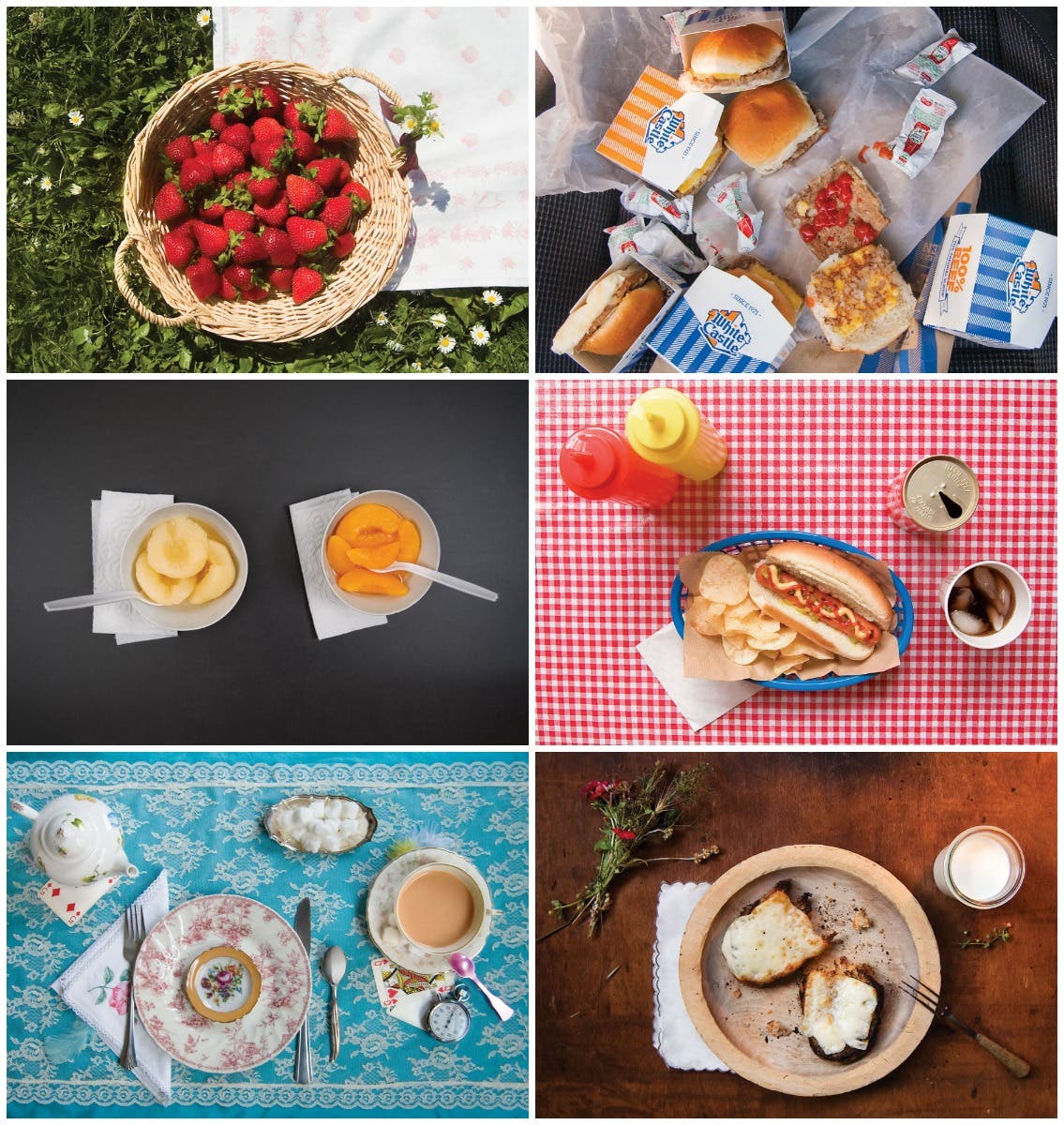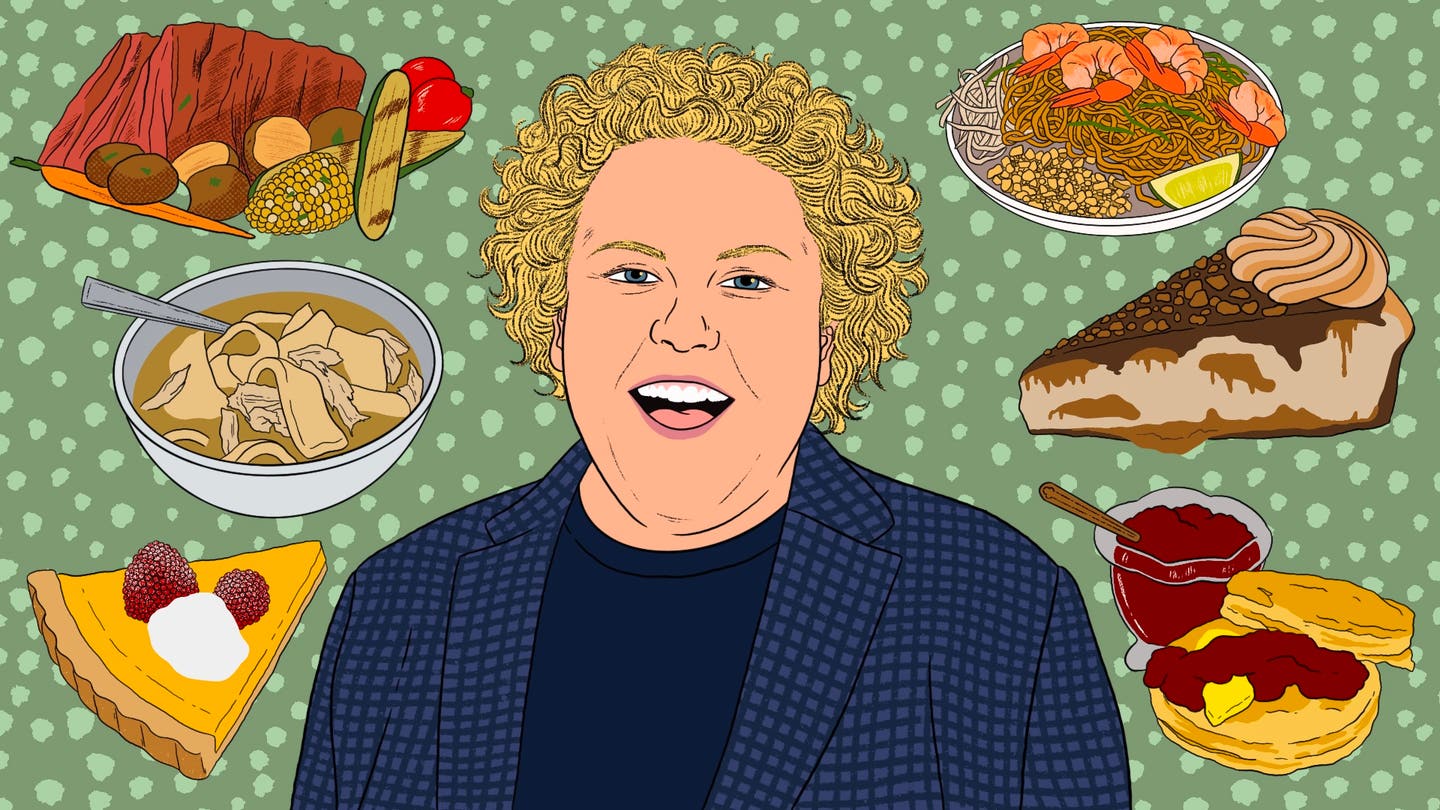
Literary Lunches
The cheese sandwich in The Catcher in the Rye; the raspberry cordial in Anne of Green Gables; the madeleines in Swann's Way—in my favorite books, the food is as important to me as any character. Artist Dinah Fried is inclined to agree. In Fictitious Dishes: An Album of Literature's Most Memorable Meals (HarperCollins, April 2014), she brings the food of fiction to life with beautifully staged photos of literature's greatest repasts. Each shot is accompanied by an excerpt from its inspiration, with annotations that give gastronomic and historical contexts. A visual library of mouthwatering moments, with the occasional witty aside (the meal for Valley of the Dolls is a sink top scattered with pills), it feeds the imagination.
Clockwise from top left:
The strawberry picnic in Emma is one of Jane Austen's most memorable scenes. "I wanted to do an Austen novel, but she actually doesn't discuss food very often, which is something I didn't really think about before getting started," says Fried. "There's so much more attention paid to the conversation, to the relationships. But I remembered that the strawberry-picking scene in Emma, a picnic scene where the character Mrs. Elton goes on and on about how much she loves strawberries as a method, on Austen's part, to demonstrate the annoyance of a certain personality type. I love the image of these women in their clean dresses and white gloves on a strawberry picnic, a scenario in which they'll probably get them all covered in juice."
The hero of Jonathan Lethem's Motherless Brooklyn seeks solace in fast food, which was a challenge for Fried. "I don't eat very much meat, and I definitely don't eat White Castle. Plus, I live in San Francisco right now, and there aren't locations out here where I am. But I have a friend who lives in Bushwick, and I asked him if he'd have any desire to go there for me. He went—I think he might have gotten himself sliders—and he asked the people behind the counter if they'd just give him empty versions of the burgers' packaging. These in the picture are the frozen White Castle sliders that you'll find at the grocery store, so that was an access thing. I had people all over the place going and getting me things. The scene was a very fun one to do, because it was such a break from the images that are so neatly styled. The protagonist in Motherless Brooklyn is a man who has Tourette's syndrome and all sorts of weird tics. One thing that calms him down is eating, so throughout the book he drives in his car and eats White Castle."
In A Confederacy of Dunces, a hot dog sets the protagonist's heart aflutter. "It's sort of a disgusting scene," says Fried of the photograph's inspiration. "The protagonist, Ignatius J. Reilly, is a grotesque character, a slovenly guy who lives with his mother. In this particular scene, he follows his nose to the hot dog, inspired by the scent of it on the air. The book takes place in the late 1970's, so the prop styling was a challenge: I wanted a Coke can that didn't have the pop-tab that we have now, which could have been quite a search. But my husband has a lot of stuff that used to be in his grandfather's basement, and we happened to find in a cabinet a Coke can that was from this precise era. I kept stumbling upon things that felt just right. I'd find myself collecting different types of paper napkins wherever I went, and among them were the perfect napkins. I want the props to feel time- and place-appropriate. My favorite thing about this whole project was fixating, being obsessed with finding something, and then discovering exactly what I was looking for."
Johanna Spyri's Heidi elevates simple cheese and bread to an incredible feast. "For me, this meal is such an intense childhood memory," Fried says. "The description of Heidi, who is an orphan, living with her grandfather, and she's so excited as she watches him melt cheese on toast for their dinner. For me that's a scene I remember reading as a child and being completely entranced by. For some reason, in children's literature for girls the main characters are so often orphans, they're deprived, and when they're given these small things that feel luxurious to them, they respond in a way that's so memorable for the reader."
Few meals are as iconic as the mad tea party in Alice's Adventures in Wonderland. Of the shot, Fried says: "This was one of the first in this series that I did. There's actually very little food in it; it's a nonsensical scene with an elaborate table setup, and the only thing they're serving is tea. I found the props in a variety of places: the little silver pieces were my grandmother's, most of the plates came from Savers in Rhode Island, a big thrift store, and the silverware came from a friend. I was asking around for props, and a friend dismissed my request saying, 'You don't want my stuff, it's all mismatched and crazy.' And I was like, 'No, that's exactly what I want! Wild and off-kilter!'"
Canned fruit is a near-unimaginable luxury in Cormac McCarthy's The Road. "This is the most spare of the images," Fried says. "It was a great challenge because McCarthy—whose writing style is also so spare—is describing a moment where a father and son, who are starving, find a trove of canned food. It's cafeteria food, we as readers don't think of it as a luxury, but in this context it was everything; the characters had to slow themselves down because they were so hungry. It's a very bleak landscape, in which this is a moment of great intensity, and so with the photo, I asked myself how to make this fruit look alive in the context of something that's otherwise very dreary."
Keep Reading
Continue to Next Story










